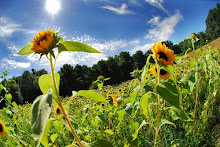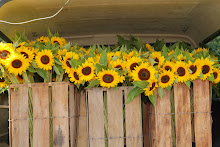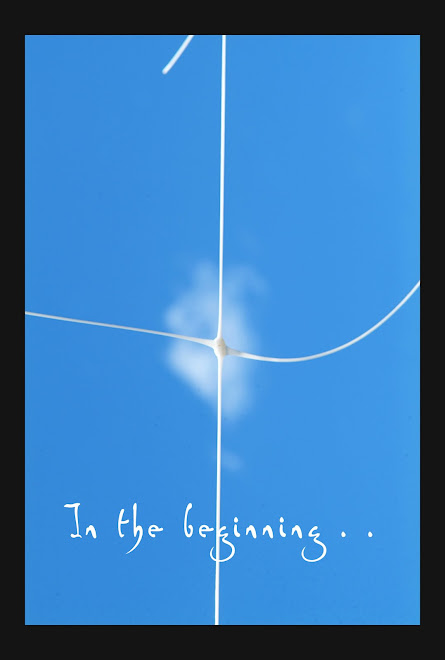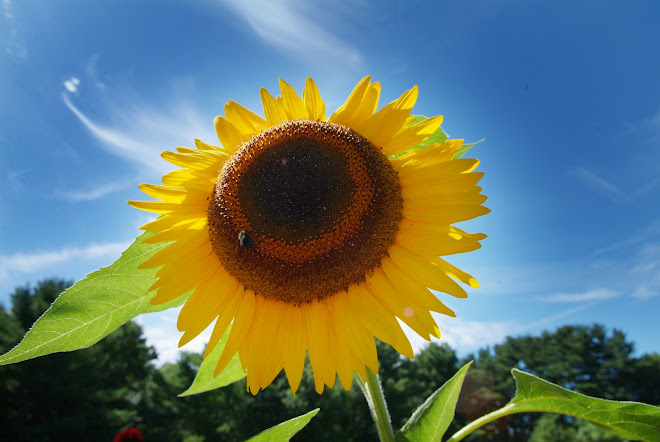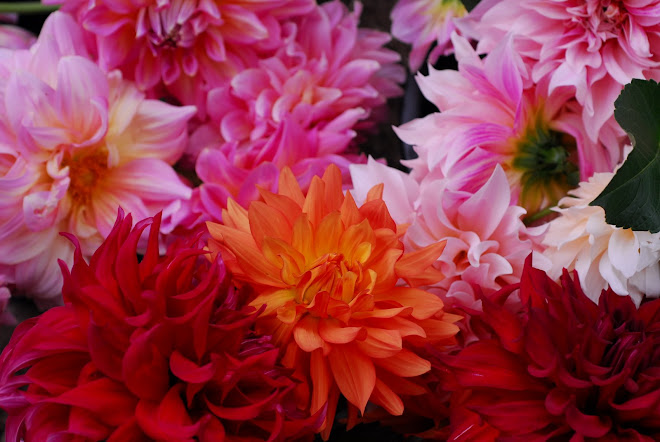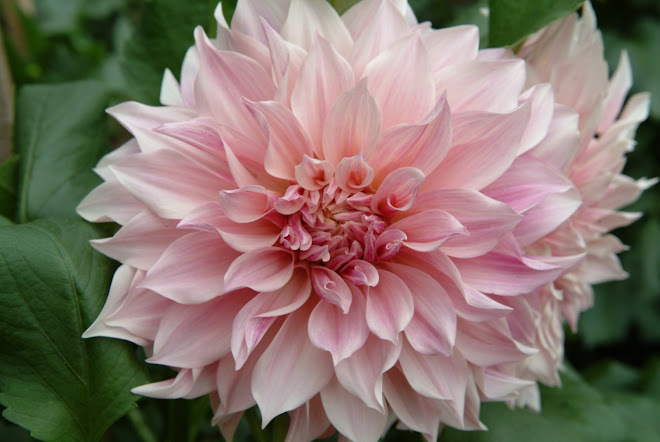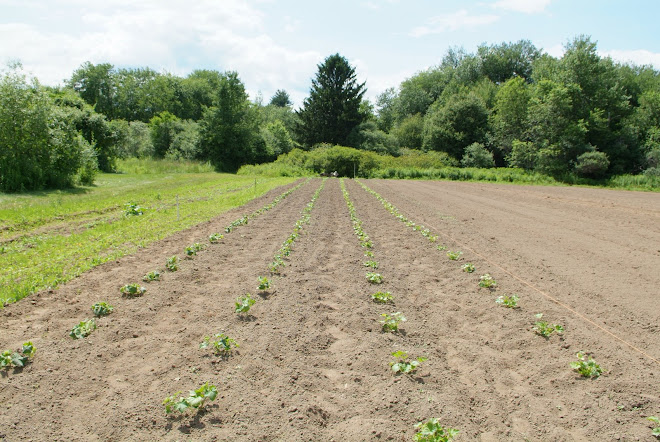



This past weekend was busy in the flower market. Easter is thankfully upon us. I worked from early morning until noon, then came home for my first Chardonnay and heated leftovers from the night before. I was settled in at home, about to watch "The Outlaw Josey Wales" from start to finish....then felt a peculiar cold grip wrapping around the steel rod in my leg (a common occurrence for anyone with foreign material holding them together). Outside, the first clouds from our next rainstorm were gathering. I turned on the "Weather Channel" and was suddenly informed of our next three day Nor'easter ripping up the coast. My wine was dumped into the sink and I gathered the necessities for our initial planting of the year.
It's peas and spinach. They are the first vegetables into the ground; they will be the first food harvested this year. Our system is simple, neat and methodical. We decide how many feet of peas we'd like to tend and ultimately eat. For us, two rows of "Caseload" shelling peas to accommodate our editor Beth and my father-in-law (he's adamant about having them for the Fourth of July), and two rows of "Sugar Snap" edible podded peas. The latter are easy and tasty, though they cannot rival fresh young shelled peas for flavor. We planted the "Caseload" in front, as they have a four foot height, then finished up with the "Sugar Snap" in the back, since the variety will climb to five or six feet. It's a matter of sunlight.....plant the shorter crops in front of the taller. This enables both types to enjoy the full rays of the early spring and summer sun.
There is an old adage: "Plant peas sparingly and you'll have a spare crop" Well said. Peas should be planted thickly, as they are thin vines that wrap around anything, including themselves.
We secured our material weeks ago from Johnny's Select Seeds in Winslow, Maine...our preferred vender. Arriving at the field, anxious and hyperventilating because of the coming storm, we brought our tools....a three pound hammer, 100ft of trimmer line (it stretches taught and holds itself well tied between stakes), four short pipes we've carried around for decades, wood ash harvested from our fireplace (a three gallon jug worth), inoculant (helps the roots of any legume synthesize nitrogen from the air), a tape measure and a plastic cup with some Vendage Chardonnay....after all, we were under the gun, and we can't handle pressure very well.
We drove our pipes into the cold soil and spaced them 50 feet apart along the border between lawn and tilled soil. Once secure, the trimmer line was stretched between the pipes to outline our impending furrow. The hand held V-hoe was pulled along the line, sinking in at just over an inch. Then we poured the inoculant into a plastic cup, tossed the pea seeds into the same and shook rigorously. This method covers each individual pea with a dusting of the legume bacteria. We remember our old mentor James Underwood Crockett and plant thickly, spreading the seeds in a band about five inches wide, not worrying if some of them are touching. once germinated, they all find their way to the sun. After sowing the row, a light dusting of wood ash supplies lime and potash....far more available than store bought lime. It's a great motivation to clean your fireplace or burn pile.
Once planted, we covered the rows by hand, being careful enough to toss any rocks that would impede the upward germination of our crop. A quick, light raking over the finished row gave us a level surface. Then a quick tamping with the iron rake secured the seeds and compressed the soil enough to withstand a rainstorm.
The peas should be up in ten days, depending on temperature. We'll share the photos when the plants greet us above the ground.
By rights, we could have left the field without apology, having planted 200 ft of peas in three hours. But, since our job in the flower market is a sink hole for time, there were no guarantees about the next planting opportunity. The unopened packet of "Space" spinach was sitting on the front bench seat of our truck. Though the skies grew ominous and heavy above us....the wet feeling arrived hours before the raindrops....we decided to race nightfall and get the spinach in the ground. Again, easy due to proven techniques. We pounded the pipes and strung the line, then again, dragged our hoe just under it, allowing no more than a half inch deep furrow.
Spinach can be sown thickly, so we tipped the seed envelope and loosely emptied it's contents along the row. Eventually, smaller plants can be yanked for salad..thinning will to enable the remaining plants to become robust large. The finished crop should be ready in 35-40 days. Because of the weekend forecas, we laid old barnboard down the rows to protect the small (and buoyant) spinach seeds. We'll provide pictures after the "Space" plants emerge.
So, the first traditional crops for our New England garden were sown on March 25, about five days later than the literature dictates, but given our unpredictable spring, Porter farms is comfortable with the timetable and the preparations we undertook to secure the seeds for a nor'easter.
Next week, we get a little busier.....buy your beet seeds, onion sets, whatever lettuce you like, and of course the radishes. Secure a few types of each so you can enjoy varied and colorful crops. We have chosen "Detroit Dark Red" beets (an old and proven variety), "Chiogga", a beet that alternates red and yellow interior rings, "Buttercrunch", "Red Sails" and "Black Seeded Simpson" lettuces, "D'Avignon" radishes and a beautiful three color assortment of onion plants from Johnny's Seeds.
Call them at 207-861-6697 and ask for Ken Fine. Tell him Patrick Porter sent you.
We'll keep working here to talk you through the season
It's peas and spinach. They are the first vegetables into the ground; they will be the first food harvested this year. Our system is simple, neat and methodical. We decide how many feet of peas we'd like to tend and ultimately eat. For us, two rows of "Caseload" shelling peas to accommodate our editor Beth and my father-in-law (he's adamant about having them for the Fourth of July), and two rows of "Sugar Snap" edible podded peas. The latter are easy and tasty, though they cannot rival fresh young shelled peas for flavor. We planted the "Caseload" in front, as they have a four foot height, then finished up with the "Sugar Snap" in the back, since the variety will climb to five or six feet. It's a matter of sunlight.....plant the shorter crops in front of the taller. This enables both types to enjoy the full rays of the early spring and summer sun.
There is an old adage: "Plant peas sparingly and you'll have a spare crop" Well said. Peas should be planted thickly, as they are thin vines that wrap around anything, including themselves.
We secured our material weeks ago from Johnny's Select Seeds in Winslow, Maine...our preferred vender. Arriving at the field, anxious and hyperventilating because of the coming storm, we brought our tools....a three pound hammer, 100ft of trimmer line (it stretches taught and holds itself well tied between stakes), four short pipes we've carried around for decades, wood ash harvested from our fireplace (a three gallon jug worth), inoculant (helps the roots of any legume synthesize nitrogen from the air), a tape measure and a plastic cup with some Vendage Chardonnay....after all, we were under the gun, and we can't handle pressure very well.
We drove our pipes into the cold soil and spaced them 50 feet apart along the border between lawn and tilled soil. Once secure, the trimmer line was stretched between the pipes to outline our impending furrow. The hand held V-hoe was pulled along the line, sinking in at just over an inch. Then we poured the inoculant into a plastic cup, tossed the pea seeds into the same and shook rigorously. This method covers each individual pea with a dusting of the legume bacteria. We remember our old mentor James Underwood Crockett and plant thickly, spreading the seeds in a band about five inches wide, not worrying if some of them are touching. once germinated, they all find their way to the sun. After sowing the row, a light dusting of wood ash supplies lime and potash....far more available than store bought lime. It's a great motivation to clean your fireplace or burn pile.
Once planted, we covered the rows by hand, being careful enough to toss any rocks that would impede the upward germination of our crop. A quick, light raking over the finished row gave us a level surface. Then a quick tamping with the iron rake secured the seeds and compressed the soil enough to withstand a rainstorm.
The peas should be up in ten days, depending on temperature. We'll share the photos when the plants greet us above the ground.
By rights, we could have left the field without apology, having planted 200 ft of peas in three hours. But, since our job in the flower market is a sink hole for time, there were no guarantees about the next planting opportunity. The unopened packet of "Space" spinach was sitting on the front bench seat of our truck. Though the skies grew ominous and heavy above us....the wet feeling arrived hours before the raindrops....we decided to race nightfall and get the spinach in the ground. Again, easy due to proven techniques. We pounded the pipes and strung the line, then again, dragged our hoe just under it, allowing no more than a half inch deep furrow.
Spinach can be sown thickly, so we tipped the seed envelope and loosely emptied it's contents along the row. Eventually, smaller plants can be yanked for salad..thinning will to enable the remaining plants to become robust large. The finished crop should be ready in 35-40 days. Because of the weekend forecas, we laid old barnboard down the rows to protect the small (and buoyant) spinach seeds. We'll provide pictures after the "Space" plants emerge.
So, the first traditional crops for our New England garden were sown on March 25, about five days later than the literature dictates, but given our unpredictable spring, Porter farms is comfortable with the timetable and the preparations we undertook to secure the seeds for a nor'easter.
Next week, we get a little busier.....buy your beet seeds, onion sets, whatever lettuce you like, and of course the radishes. Secure a few types of each so you can enjoy varied and colorful crops. We have chosen "Detroit Dark Red" beets (an old and proven variety), "Chiogga", a beet that alternates red and yellow interior rings, "Buttercrunch", "Red Sails" and "Black Seeded Simpson" lettuces, "D'Avignon" radishes and a beautiful three color assortment of onion plants from Johnny's Seeds.
Call them at 207-861-6697 and ask for Ken Fine. Tell him Patrick Porter sent you.
We'll keep working here to talk you through the season
